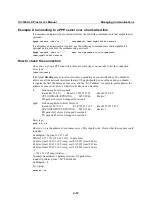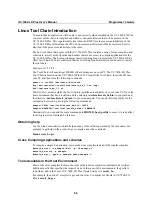
UC-7400-LX Plus User’s Manual
Managing Communications
4-26
3.
Check the routing table after you run the OpenVPN programs, by typing the command:
# route
Destination Gateway
Genmsk Flags
Metric
Ref
Use
Iface
192.168.4.174 * 255.255.255.255
UH
0
0
0
tun0
192.168.4.0 192.168.4.174
255.255.255.0 UG 0 0 0 tun0
192.168.2.0 *
255.255.255.0
U
0
0
0
eth1
192.168.8.0 *
255.255.255.0
U
0
0
0
eth0
IPv6 to IPv4 Tunneling
Note: The IPv6 feature is provided starting with firmware version v1.6. After upgrading the
firmware, you must load the factory default to activate the IPv6 feature.
IPv6 to IPv4 tunneling provides a simple way to enable the new generation IP protocol on your
Linux host by tunneling IPv6 packets over an IPv4 connection. This section will explain how to
configure your computer and enable the IPv6 to IPv4 tunneling function.
Step1: Connect the computer’s LAN1 port to the Internet.
If your Linux system has a static IPv4 address, the tunnel can also be statically configured in the
network definitions. Assume your IPv6 Internet is connected via LAN1; you can configure the
IPv6 to IPv4 tunnel through the LAN1 port (eth0) by connecting to the IPv6 network behind the
IPv6 gateway.
Step 2: Configure LAN1 (eth0) IPv4 network settings.
(The values and parameters used below are for illustration only. Be sure to enter the correct values
and parameters for your network.)
Let’s assume that the following settings represent your network’s current situation:
IP: 61.56.74.14 (Global)
Mask:
255.255.255.248
Gateway:
61.56.74.9
Moxa
embedded
computer
IPv4
network
LAN1
(eth0)
IPv6
gateway
192.88.99.1
IPv6 network






























